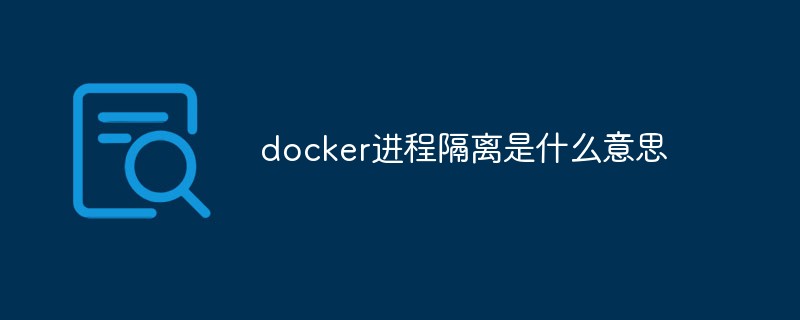What does docker process isolation mean?
In docker, process isolation means running each container in its own process environment; Docker mainly uses the Linux kernel technology Namespace to achieve isolation. The "Linux Namespaces" mechanism provides a Resource isolation scheme.

The operating environment of this tutorial: linux7.3 system, docker version 19.03, Dell G3 computer.
What does docker process isolation mean
Process isolation: Each container runs in its own process environment
Isolation principle
Docker mainly relies on the Linux kernel technology Namespace to achieve isolation. The Linux Namespaces mechanism provides a resource isolation solution. System resources such as PID, IPC, and Network are no longer global, but belong to a specific Namespace.
The resources under each namespace are transparent and invisible to the resources under other namespaces. Therefore, at the operating system level, there will be multiple processes with the same pid. There can be two processes with process numbers 0, 1, and 2 in the system at the same time. Since they belong to different namespaces, there is no conflict between them. At the user level, only resources belonging to the user's own namespace can be seen. For example, using the ps command can only list processes under the user's own namespace. This way each namespace looks like a separate Linux system.

Process Isolation
Start a container
docker run -it -p 8080:8080 --name pai-sn pai-sn:snapshot /bin/bash
-it interactive startup, -p port mapping, –name The container name is followed by the image name, open the shell, and enter the container after startup
View the process
ps -ef

Use the top command to view the process resources

Check the process of the currently executing container on the host machine ps -ef|grep pai-sn

From this, we can know that the docker run command starts only one process, and its pid is 4677 . As for the container program itself, it is isolated, and only its own internal processes can be seen inside the container. Docker is implemented with the help of the Namespace technology of the Linux kernel.
Recommended learning: "docker video tutorial"
The above is the detailed content of What does docker process isolation mean?. For more information, please follow other related articles on the PHP Chinese website!

Hot AI Tools

Undresser.AI Undress
AI-powered app for creating realistic nude photos

AI Clothes Remover
Online AI tool for removing clothes from photos.

Undress AI Tool
Undress images for free

Clothoff.io
AI clothes remover

Video Face Swap
Swap faces in any video effortlessly with our completely free AI face swap tool!

Hot Article

Hot Tools

Notepad++7.3.1
Easy-to-use and free code editor

SublimeText3 Chinese version
Chinese version, very easy to use

Zend Studio 13.0.1
Powerful PHP integrated development environment

Dreamweaver CS6
Visual web development tools

SublimeText3 Mac version
God-level code editing software (SublimeText3)

Hot Topics
 How to exit the container by docker
Apr 15, 2025 pm 12:15 PM
How to exit the container by docker
Apr 15, 2025 pm 12:15 PM
Four ways to exit Docker container: Use Ctrl D in the container terminal Enter exit command in the container terminal Use docker stop <container_name> Command Use docker kill <container_name> command in the host terminal (force exit)
 How to check the name of the docker container
Apr 15, 2025 pm 12:21 PM
How to check the name of the docker container
Apr 15, 2025 pm 12:21 PM
You can query the Docker container name by following the steps: List all containers (docker ps). Filter the container list (using the grep command). Gets the container name (located in the "NAMES" column).
 How to copy files in docker to outside
Apr 15, 2025 pm 12:12 PM
How to copy files in docker to outside
Apr 15, 2025 pm 12:12 PM
Methods for copying files to external hosts in Docker: Use the docker cp command: Execute docker cp [Options] <Container Path> <Host Path>. Using data volumes: Create a directory on the host, and use the -v parameter to mount the directory into the container when creating the container to achieve bidirectional file synchronization.
 How to restart docker
Apr 15, 2025 pm 12:06 PM
How to restart docker
Apr 15, 2025 pm 12:06 PM
How to restart the Docker container: get the container ID (docker ps); stop the container (docker stop <container_id>); start the container (docker start <container_id>); verify that the restart is successful (docker ps). Other methods: Docker Compose (docker-compose restart) or Docker API (see Docker documentation).
 How to start mysql by docker
Apr 15, 2025 pm 12:09 PM
How to start mysql by docker
Apr 15, 2025 pm 12:09 PM
The process of starting MySQL in Docker consists of the following steps: Pull the MySQL image to create and start the container, set the root user password, and map the port verification connection Create the database and the user grants all permissions to the database
 How to update the image of docker
Apr 15, 2025 pm 12:03 PM
How to update the image of docker
Apr 15, 2025 pm 12:03 PM
The steps to update a Docker image are as follows: Pull the latest image tag New image Delete the old image for a specific tag (optional) Restart the container (if needed)
 How to start containers by docker
Apr 15, 2025 pm 12:27 PM
How to start containers by docker
Apr 15, 2025 pm 12:27 PM
Docker container startup steps: Pull the container image: Run "docker pull [mirror name]". Create a container: Use "docker create [options] [mirror name] [commands and parameters]". Start the container: Execute "docker start [Container name or ID]". Check container status: Verify that the container is running with "docker ps".
 How to create containers for docker
Apr 15, 2025 pm 12:18 PM
How to create containers for docker
Apr 15, 2025 pm 12:18 PM
Create a container in Docker: 1. Pull the image: docker pull [mirror name] 2. Create a container: docker run [Options] [mirror name] [Command] 3. Start the container: docker start [Container name]






